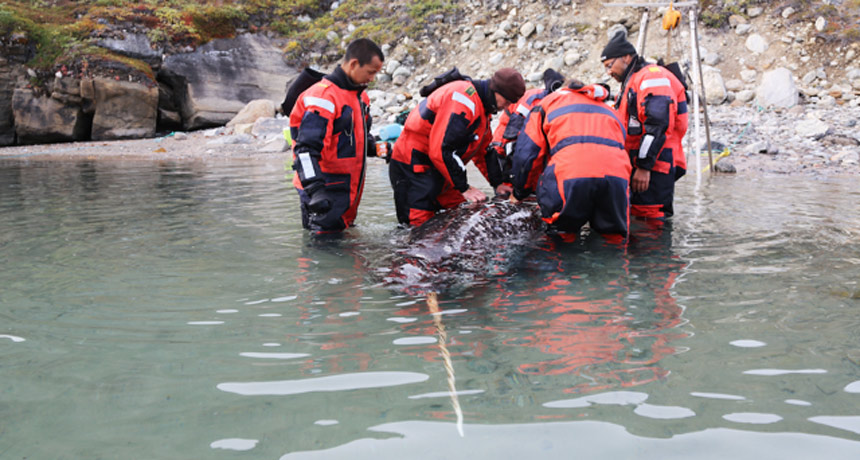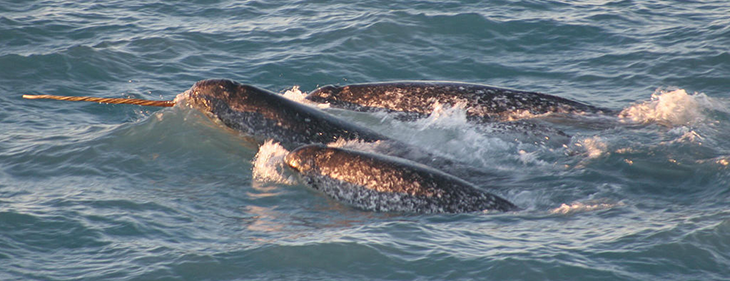Here’s what narwhals sound like underwater
Multi-day eavesdropping reveals a range of clicks, calls and buzzes

Researchers put a sound recording device on a male narwhal to capture its underwater clicks, buzzes and calls.
S. Blackwell
Share this:
- Share via email (Opens in new window) Email
- Click to share on Facebook (Opens in new window) Facebook
- Click to share on X (Opens in new window) X
- Click to share on Pinterest (Opens in new window) Pinterest
- Click to share on Reddit (Opens in new window) Reddit
- Share to Google Classroom (Opens in new window) Google Classroom
- Click to print (Opens in new window) Print
Narwhals are among the most elusive of whales. But for the first time, researchers have been able to listen in on their chatter for days at a time. A team eavesdropped on these “unicorns of the sea” as they dove, fed and socialized.
Susanna Blackwell is a biologist who studies ocean mammals. One of her interests is underwater sounds and how they affect marine animals. She works at a company called Greeneridge Sciences, Inc., in Santa Barbara, Calif. She wants to know how narwhals use different sounds in their daily lives.
Blackwell and her colleagues listened in on the clicks, buzzes and calls of the East Greenland narwhal. What they learned could help future studies of whether the whales might be disturbed by human-made noise from fishing or oil drilling, the scientists hope.
Narwhals rely on sound in the dark Arctic waters where they live. Like other species of toothed whales, narwhals use echolocation to hunt. “They’re like wet bats,” says Kate Stafford. She studies whales and their songs at the University of Washington in Seattle. but was not part of the new study.
Whale sounds are often recorded using hydrophones (HIGH-druh-fohnz). These special underwater microphones dangle in the water to collect sounds. But these devices have a few drawbacks. They can’t sense the depth or direction from which noise comes. And they can’t tell which animal is making what sound.
So Blackwell and her colleagues came up with a different solution. They attached acoustic recording devices to the narwhals themselves. “It is really like sitting on the back of a narwhal for a few days and experiencing the world,” Blackwell says.
Story continues below image.

How to eavesdrop on a narwhal
With the help of native Greenland hunters, the researchers tagged six of the skittish creatures between 2013 and 2016. The devices stuck to the whales with suction cups. Nylon string threaded through a ridge of cartilage on the narwhals’ backs. This string held the devices in place. Special links to the string were designed to degrade fairly quickly. After three to eight days in the water, the links broke apart. This released the devices from the whales. The recorders then floated to the surface, where researchers could track and retrieve them.
The whales were very quiet on the first day they wore those devices. That’s probably because tagging was stressful for them, says Blackwell. But after that, the narwhals resumed their normal behavior — and chatter.
The acoustic devices captured a rich repertoire of narwhal sounds. And the whales made them during different activities and at different water depths.
“We were very surprised that they actually have a very specialized way of using sound,” says study coauthor Mads Peter Heide-Jørgensen. He is a biologist at the Greenland Institute of Natural Resources based in Copenhagen, Denmark.
Story continues below audio.
Several whales socialize with each other at a depth of 65 meters (210 feet), using clicks, whistles and trumpet sounds.
A female narwhal communicates using pulselike sounds as she swims near the surface of the ocean.
Audio: S. Blackwell
Narwhals search deep waters for squid and fish such as Arctic and polar cod. And they clicked while diving to locate such prey. As a whale closed in on a meal, its clicks turned into a rapid buzzing. At the surface, the narwhals instead used whistles and trumpetlike calls to communicate.
The part of East Greenland where the narwhal research took place is very remote. But it likely won’t be for long, says Jens Koblitz. He studies animal sounds at the University of Konstanz in Germany. Global warming is melting Arctic sea ice. As that ice recedes, fishing boats, oil-seeking ships and others are expected to spend more time in the region. Thanks to climate change, human presence in the Arctic is already on the rise , Koblitz says. And all those ships and people bring more noise.
It’s vital to learn about the whales’ behavior while their habitat is still fairly isolated, says Stafford. Such information, she says, will help researchers see any changes caused by more human activity in the area.
If scientists discover that human sounds disturb narwhals, they may recommend limiting human activity in some areas, Heide-Jørgensen says.
His team described the narwhale sounds June 13 in the journal PLOS ONE.







